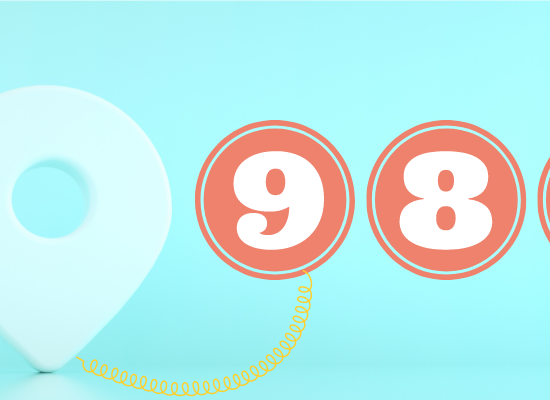
Stephanie Hepburn is a writer in New Orleans. She is the editor in chief of #CrisisTalk. You can reach her at .
Craig Miller says he’s grateful for 988, the newly launched nationwide three-digit number for mental health, substance use, and suicidal crises. Not just for the number itself, but because it shows people who are struggling that those in power, like legislators and agency heads, care. “When you feel ‘they’ care—the elusive ‘they’ who have more control over the system than we do—it matters.”
Between when the National Suicide Hotline Designation Act of 2020, passed on October 17, 2020, and the launch of 988 on July 16, 2022, states had to prepare for implementation quickly. Miller says the nearly 21-month period was like no other time he’s seen in his more than a decade of suicide prevention advocacy. “It fostered an unbelievably awesome exchange of information.” State leaders and advocates shared best practices with one another, and a spark of innovation ignited in a way often reserved for physical but not behavioral health.
With 988 on the horizon, there was rising pressure to prepare communities for increased volume throughout behavioral health crisis systems. So when July 16 arrived, states had to be as ready as possible. “It was coming, and state leaders and their partners were scrambling and coming up with innovative ideas to make things work,” says Miller. Without 988, he doesn’t believe the push would have ever happened, or at least not at the pace that it did.
When the Federal Communications Commission began the process to formally make 988 the nationwide number for mental health and suicide crisis, the word “parity” came to mind for many advocates. In December 2019, FCC Chairperson Ajit Pai said a dedicated 3-digit number would reduce stigma around suicide and mental health and “ultimately save lives.”
“It’s the first national effort like this that we’ve ever seen,” says Miller. “They’re finally telling us, ‘We are giving you help, we are here if you need us, and tell everyone to call this number.’”
However, there’s a lot of pressure on 988 call centers and other parts of the crisis system, like mobile crisis services and short-term crisis stabilization facilities. “We’ve been talking about suicide prevention for ages, and now there’s a nationwide number, but it has to work,” says Miller. He worries that if it doesn’t, it will feel worse than if it had never existed. “If people in crisis call 988 and it doesn’t work out, it’s so bad because they might never have faith in the system again.”
A person’s introduction to the behavioral health crisis system can shape their willingness to interact with and trust in it. “By the time someone calls 988, they’ve likely carried pain for a long time,” says Miller. He knows this because he’s had thoughts of suicide since he was eight years old. Throughout his childhood, a neighbor sexually abused him. Almost all the abuse happened in the crawl space beneath Miller’s home. “I could hear my family walking around above me.”
His childhood wasn’t a happy one. “I thought, ‘If this is what life is, I don’t want it,’” he says. In a video called ‘What If,’ a Perspective on Suicide, he shares that when he was eight, he’d go to sleep with covers over his head hiding from the “…fighting, screams, and breaking glass that’s coming from the other room in a place that I’m forced to call my home.” His pain culminated in a suicide attempt when he was 20 years old.
Miller, author of This Is How It Feels: A Memoir – Attempting Suicide and Finding Life, points out that people often misunderstand suicidal ideation and suicide attempts, thinking it means the person wants to die. “That’s not it. I didn’t want to die, but I was willing to die to no longer feel the way I did.” Understanding the distinction was an “ah-ha” moment for him, giving Miller the space to try to understand why he attempted suicide and discover what it meant to him. “I realized I wanted—no, needed—something to change but felt incapable of changing it.”
Later, he took apart his experiences, looking at them as if from a distance, and it made him realize he no longer was that eight-year-old boy who had to hide under the bed. “Yes, I wish I’d never been molested or bullied and didn’t have the upbringing I did, but I also realized life itself had changed.”
At that moment, Miller saw an opportunity to take control of his life, and if he could find a way forward, he could teach others to do the same.
Many experts would say he felt hope, but he’s tired of that word. “It’s all over T-shirts and suicide prevention marketing, but what does it even mean to have hope?” He says people can’t just say (or wear) the word and then walk away. “It’s like telling people to ‘feel loved.’” “It’s an emotion; you can’t instruct people to feel a certain way.” Instead, people in the suicide prevention space need to explain what it means. For Miller, hope doesn’t mean that everything will be okay, but that he will be okay no matter what happens.
“That makes everything in my life, every experience I’ve ever had, internal and within my control. So I can choose how I feel about those experiences, what I keep from them, and what I let go.”
However, if a person’s first interaction with mental health or substance use care isn’t positive, or worse, it’s negative, that harms a person’s trust and belief that they could feel differently. “You’re going to feel like, ‘See, even they can’t help me.’” “It can be a make-or-break moment for someone.”
That’s why crisis response must center on what people in crisis need. He says cross-state engagement, with the increased understanding that the default responders to behavioral health crises should be mental health teams, not law enforcement, has created a critical shift. “I can’t even imagine how different that experience would be versus a police officer showing up.”
He’s had two interactions with law enforcement. One resulted in a group of police officers surrounding him, and the other was with an officer who was kind and caring and took him to the hospital. “She all but held my hand,” says Miller. However, he points out that the uniform itself can feel threatening and intimidating. “Even during the positive interaction, I still felt like I was in trouble.”
The Covid pandemic has exacerbated the mental health and substance use crises that were already happening in the United States. Deaths related to synthetic opioids, psychostimulants, and cocaine have spiked, and an increased proportion of people have gone to the emergency room for behavioral health reasons, especially young people. However, Miller points out that compassion has also been a byproduct of these public health emergencies. It’s a moment he says the behavioral health space must capitalize on. “There isn’t just a mental health crisis happening, but also a mental health movement.”
You can learn more about Craig Miller in his interview with Moving America’s Soul on Suicide, a documentary featuring stories of suffering and stories of courage. When suicidal, people often asked him why he wanted to die. He learned the better question was why to live.









